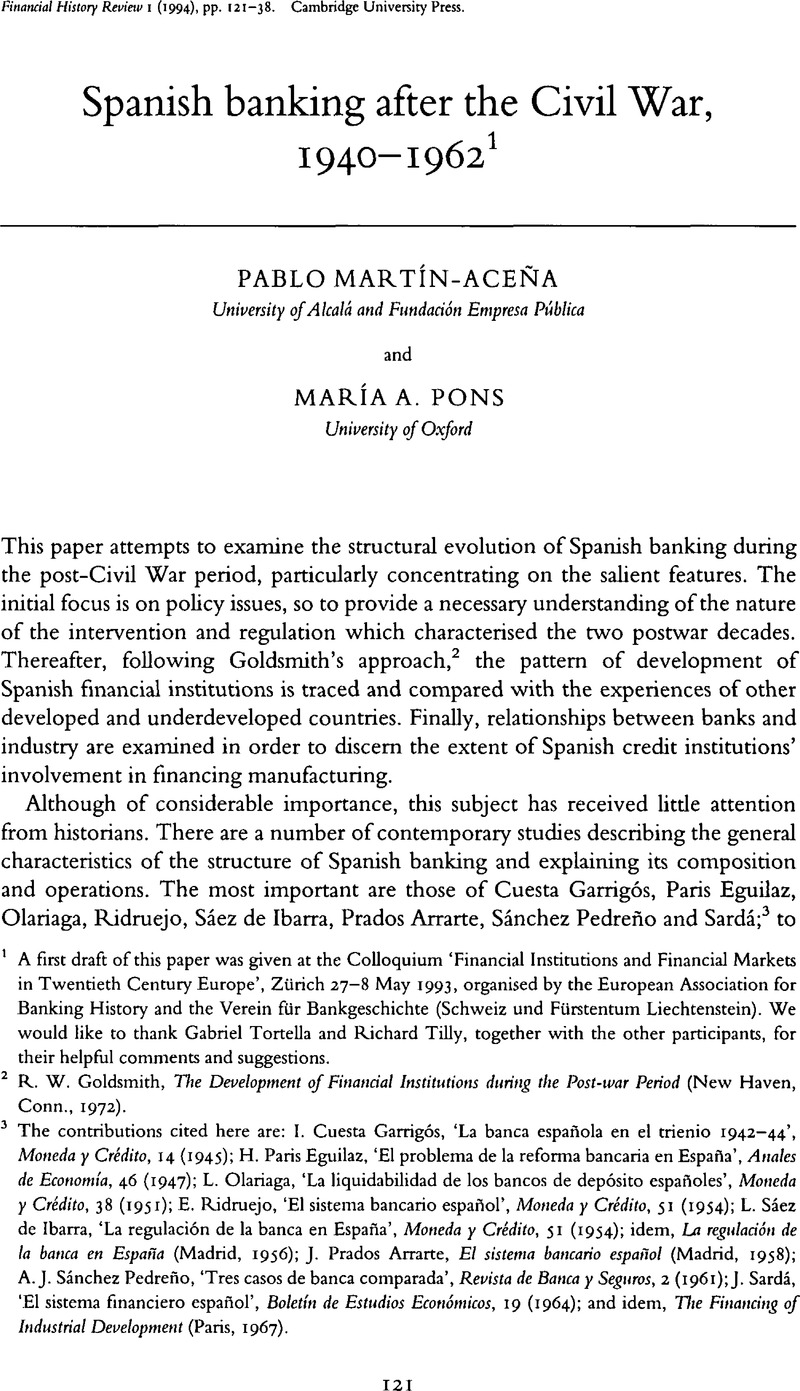Published online by Cambridge University Press: 12 September 2008

2 Goldsmith, R. W., The Development of Financial Institutions during the Post-war Period (New Haven, Conn., 1972).Google Scholar
3 The contributions cited here are: Garrigós, I. Cuesta, ‘La banca española en el trienio 1942–44’, Moneda γ Crédito, 14 (1945)Google Scholar; Eguilaz, H. Paris, ‘El problema de la reforma bancaria en España’, Anales de Economía, 46 (1947)Google Scholar; Olariaga, L., ‘La liquidabilidad de los bancos de depósito españoles’, Moneda γ Crédito, 38 (1951)Google Scholar; Ridruejo, E., ‘El sistema bancario español’, Moneda γ Crédito, 51 (1954)Google Scholar; Sáez de Ibarra, L., ‘La regulación de la banca en España’, Moneda γ Crédito, 51 (1954)Google Scholar; idem, La regulación de la banca en España (Madrid, 1956); Arrarte, J. Prados, El sistema bancario español (Madrid, 1958)Google Scholar; Pedreño, A. J. Sánchez, ‘Tres casos de banca comparada’, Revista de Banca γ Seguros, 2 (1961)Google Scholar; Sardá, J., ‘El sistema financiero español’, Boletín de Estudios Económicos, 19 (1964)Google Scholar; and idem, The Financing of Industrial Development (Paris, 1967).
4 Clayton, G., ‘Spain’, in Sayers, R. S. (ed.), Banking in Western Europe (Oxford, 1973).Google Scholar
5 The contributions cited here are: Cortiña, R. Martínez, Crédito γ banca en España: análisis γ estructura (Madrid, 1971)Google Scholar; Roa, A. López, Sistema financiero español (Alicante, 1981)Google Scholar; Cuervo, A., ‘Banca e industrialización en el período 1960–88’, in Banca e industrialización: presente, pasado γ faturo (Madrid, 1988)Google Scholar; Mañas, A. Torrero, Banca e industrialización en España: pasado, presente γ futuro (Madrid, 1988)Google Scholar; idem, Estudios sobre el sistema financiero (Madrid, 1989); and idem, Relaciones banca-industria: la experiencia española (Madrid, 1991).
6 For a detailed analysis of the 1921 Act, see Martín-Aceña, P., La política monetaria en España, 1919–1935 (Madrid, 1984), ch. 2Google Scholar; and Tortella, G., ‘El Banco de España entre 1829–1929. La formación de un banco central’, in El Banco de España. Una historia económica (Madrid, 1970), pp. 303–6.Google Scholar
7 For a comprehensive account of the evolution of the Spanish financial system during the Civil War, see Asiaín, J. A. Sánchez, La banca española en la Guerra Civil, 1936–1939 (Madrid, 1993), chs. 3 and 4.Google Scholar
8 Sardá, J., ‘El Banco de España (1931–1962)’, in El Banco de España, pp. 447–54Google Scholar; and Martín-Aceña, P., Los problemas monetarios al término de la Guerra Civil, Working Paper 0191 (Madrid, 1991).Google Scholar
9 The existence of barriers to entry does not mean that the number of banks remained unaltered during the period, since new regional and local banks were authorized to open. However, they did not significantly modify the structure of the Spanish banking system established after the war.
10 Paris, Eguilaz, ‘El problema de la reforma bancaria’, p. 216.Google Scholar Nevertheless, these controls did not avoid collusive agreements; see Consejo Superio Bancario, Circular 436 (1952).Google Scholar
11 A detailed account of banking regulations after the civil war is part of Pons's, M. A. current doctoral work for her thesis, ‘Financial Regulations in Spain, 1940–1970’ (University of Oxford).Google Scholar
12 The perverse results of this distinction led in 1974 to its abrogation.
13 These coefficients froze 25 per cent of banks' liabilities during the following decade. The law also introduced a cash ratio, which was not effective until 1971, and a more imprecise liquidity ratio.
14 The sample was evenly divided between developed and less developed countries; for the list of countries included, see Goldsmith, , Development of Financial Institutions, tables 1 to 28.Google Scholar
15 Ibid., p. 6.
16 Among DCs, only in France (2 per cent), Italy (3 per cent) and Japan (3·3 per cent) were these rates higher.
17 Taken from Goldsmith, , Development of Financial Institutions, table 21.Google Scholar
18 See Martín-Aceña, P., ‘Economic growth and financial development in Spain (1900–1930)’, in Aerts, E. and Valério, N. (eds), Growth and Stagnation in the Mediterranean World (Leuven, 1990)Google Scholar; Muñoz, J., El poder de la banca en España (Madrid, 1978)Google Scholar; Roldán, S. and Delgado, J. L. García, La formación de la sociedad capitalista en España (Madrid, 1973)Google Scholar; and Tortella, G. and Palafox, J., ‘Banking and industry in Spain, 1918–1936’, Journal of European Economic History, 13, special issue (1984).Google Scholar
19 Serrano, J. A. Martínez et al. , Economía española: 1960–1980 (Madrid, 1982), pp. 253–5.Google Scholar
20 Torrero, Mañas, Relaciones banca-industria, p. 11 et seq.Google Scholar
21 ibid. p. 18.
22 Here the approach of Sánchez Pedreño, ‘Tres casos de banca comparada’, is followed.
23 For Germany and Italy two set of figures are offered, one including only data for commercial banks, and the other including all types of financial institutions; this takes into account differences in the composition of the three financial systems.
24 Data taken from Sánchez, Pedreño, ‘Tres casos de banca comparada’, p. 11.Google Scholar